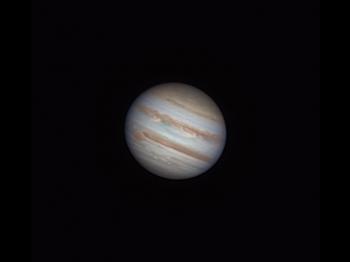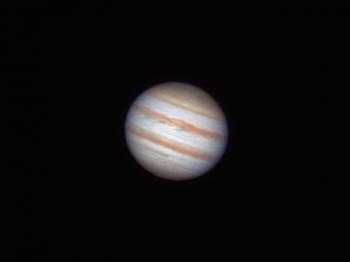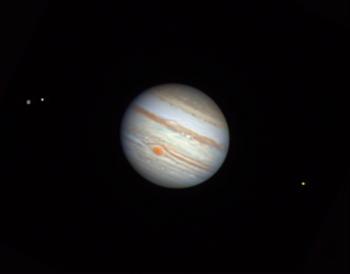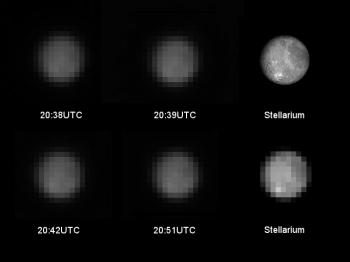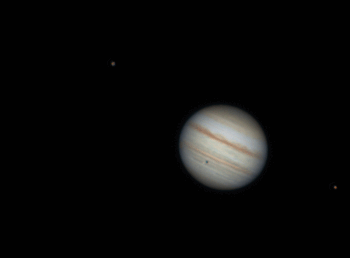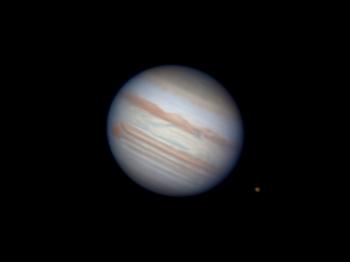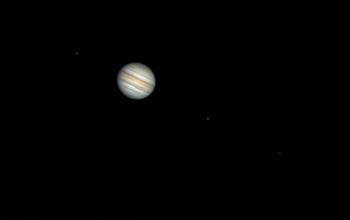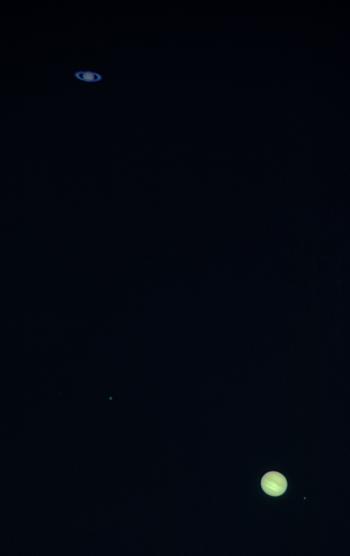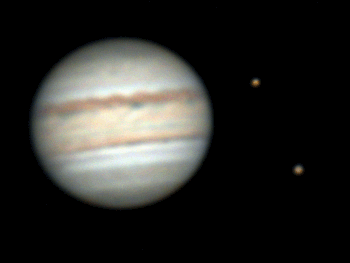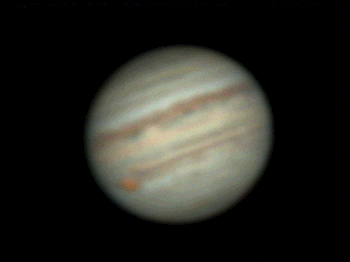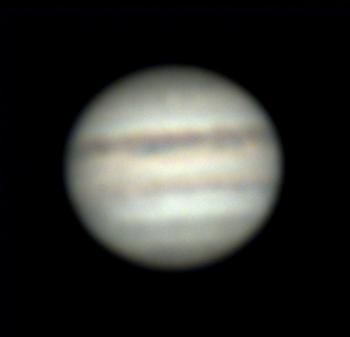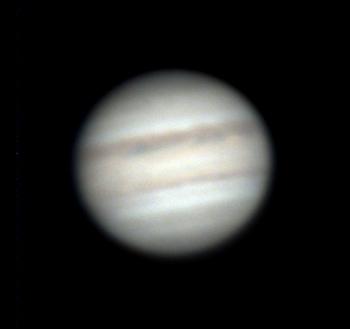JupiterThe next planet after Mars is Jupiter. It is the largest planet in the solar system and will be the subject of my next research. With its coloured bands and the bright Galilean moons it is an attractive object in the skies. 27 January 2025By the end of January I had another opportunity to image Jupiter. The image was taken around 19:02UTC, after having imaged Venus around 18:02UTC. Imaging was done with the Celestron C11 XLT EdgeHD, TeleVue 2x Powermate, ZWO EFW mini with ZWO LRGB filters, ZWO ADC and ZWO ASI174MM. The ADC was adjusted using a ZWO ASI290MC, focussing was done using a Bahtinov mask and Jupiter's moons (from left to right) Ganymede and Io, the latter of which casts its shadow on the planet. Jupiter's apparent diameter was 43.97 arc-seconds. Using FireCapture four LRGB-sequences of 30 seconds per filter at 200FPS were collected. This was done at a gain of 300, resulting in exposure times of 6ms for L and 10ms for RGB. Processing was done in AutoStakkert!, stacking 50% of the L-frames and 35% for RGB, with sharpening at a 30% blend. Postprocessing was done in WinJupos. The image was given a 19% vibrancy, but no further sharpening was done. Click here for the full image. 2 January 2025After yet another fully overcast autumn (2024-2025) the skies finally more or less cleared on 2 January. I started imaging Jupiter around 19:15UTC. Imaging was done with the Celestron C11 XLT EdgeHD, TeleVue 2x Powermate, ZWO EFW mini with ZWO LRGB filters, ZWO ADC and ZWO ASI174MM. The ADC was adjusted using a ZWO ASI290MC, focussing was done using a Bahtinov mask and Jupiter's moons (from left to right) Io and Ganymede. Jupiter's apparent diameter was 46.88 arc-seconds. Using FireCapture four LRGB-sequences of 60 seconds per filter at 200FPS were collected. This was done at a gain of 300, resulting in exposure times of 3ms for L and 9ms for RGB. Processing was done in AutoStakkert!, stacking 75% of the L-frames and 55% for RGB, with sharpening at a 30% blend. Postprocessing was done in WinJupos. The image was given a 19% vibrancy, but no further sharpening was done. Click here for the full animation. The three sub-frames of the animation can be found here (19:15UTC), here (19:19UTC), and here (19:29UTC). 18 January 2024On 18 January 2024 the Moon and Jupiter came around in ecliptic conjunction. At 19:53:38UTC both objects had an ecliptic longitude of 36°10’48.5″ and the, at that moment almost straight, terminator of the Moon pointed towards Jupiter (the Moon was at that moment 57.1% illuminated). Two hours before that moment I was able to capture the at that moment not yet complete conjunction with the SkyWatcher Esprit 80ED at f/5 and with a ZWO ASI1600MM Pro Cool in one image (Jupiter with four moons can be seen all the way to the bottom left). Thanks to this conjunction we can now appreciate the difference in size between them. The image was made with FireCapture. In 30 seconds 277 frames were recorded at a shutter speed of 1.9ms. With AutoStakkert v4.09 30% (83 frames) of this were stacked. The normal stack was used as a basis, but the four moons of Jupiter come from the sharpened stack that was made with 30% raw blend, because otherwise the moons would have remained too dark (from left to right they are Callisto, Ganymede, Io and Europa). The image shown here is a combination of the two stacks. The composition was done in PSP. The plate with only Jupiter and the moons is a crop that was then scaled up by 400%. Click here for the full image. 25 November 2023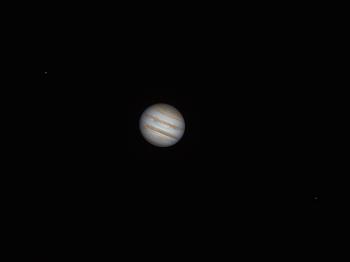 Figure 4: Jupiter with Io (left) and Europe as imaged on 25 November 2023 around 21:03UTC with the C11 EdgeHD. After a month of fully overcast skies 25 November 2023 finally had a more or less clear sky over InFINNity Deck. Seeing was reasonable this day and evening and I started imaging Jupiter around 21:03UTC, after having imaged by Saturn around 17:02UTC. Imaging was done with the Celestron C11 XLT EdgeHD, TeleVue 2x Powermate, ZWO EFW mini with ZWO LRGB filters, ZWO ADC and ZWO ASI174MM. The ADC was adjusted using a ZWO ASI290MC, focussing was done using a Bahtinov mask and Jupiter's moons (from left to right) Io and Europe. Using FireCapture four LRGB-sequences of 60 seconds per filter at 200FPS were collected. This was done at a gain of 300, resulting in exposure times of 3ms for L and 10ms for RGB. Processing was done in AutoStakkert!, stacking 65% of the L-frames and 50% for RGB, with sharpening at a 30% blend. Postprocessing was done in WinJupos. The image was given 30% saturation an additional sharping and then low-light denoised in Topaz. Click here for the full image. A few minutes later I only captured the planet itself using the same equipment and settings as above. Post-processing too was done in the same way. Click here for the full image. Another 9 minutes later I recorded another image of Jupiter, which can be found here. 22 October 2023On 22 October 2023 we had a few clear moments. Three series of 60 seconds recordings were made between 20:47UTC and 21:49UTC in LRGB using the Celestron C11 XLT EdgeHD, TeleVue 2x PowerMate, ZWO ADC, ZWO EFW Mini with ZWO LRGB filters and ZWO ASI174MM. The ADC was adjusted using a ZWO ASI290MC, focusing was done with the ASI174MM and a Bahtinov-mask on Io and Ganymede. Using FireCapture four LRGB-sequences of 60 seconds per filter at 200FPS were collected. This was done at a gain of 300, resulting in exposure times of 5ms for L and 10ms for RGB. Processing was done in AutoStakkert!, stacking 50% of the frames for L, 15% for R, 45% for G and 25% for B, with sharpening at a 30% blend. Postprocessing of the convoluted files was done in WinJupos. The image was given 30% saturation and given some vibrancy. Click here for the full image. 9 November 2022After a week of fully overcast skies 9 November 2022 finally had a more or less clear sky over InFINNity Deck. Seeing was quite good this evening and I started imaging Jupiter around 20:38UTC, followed by Mars around 22:02UTC. Imaging was done with the Celestron C11 XLT EdgeHD, TeleVue 2x Powermate, ZWO EFW mini with ZWO LRGB filters, ZWO ADC and ZWO ASI174MM. The ADC was adjusted using a ZWO ASI290MC, focussing was done using a Bahtinov mask and (from left to right) Ganymede, Europe and Io. Using FireCapture four LRGB-sequences of 60 seconds per filter at 200FPS were collected. This was done at a gain of 300, resulting in exposure times of 5ms for L and 10ms for RGB. Processing was done in AutoStakkert!, stacking 50% of the frames, and with sharpening at a 30% blend. Postprocessing was done in WinJupos. The image was given 30% saturation and given some vibrancy. Click here for the full image. In total four luminance runs were done this night, the first two were part of a full LRGB sequence that got interrupted by clouds. When looking at the stacks of these four runs it appears that I managed to get some surface detail of Ganymede. At the left the four runs are shown, at the right Ganymede as it would have been around that time according to Stellarium. At the lower right a pixelated version of the upper right image is show (pixelated at the same scale as the original recordings), this to be able to compare the images even better. According to Stellarium Ganymede's apparent diameter was only 1.71 arc-seconds during these recordings. The pixel scale of the imaging train (C11 EdgeHD, 2x PowerMate, ASI174MM) was approximately 0.217 arc-seconds, making the full disc approximately 8 pixels (in the images it is about 9px). 24 September 2022On 24 September 2022 we had a clear night, but with clouds approaching from the north. As the expectation was that the second half of the night would be overcast it was not suitable for deep-sky imaging. Instead I decided to do some work on Jupiter. The constellation was favourable with three of the Jovian moons nearby (Io at the right, Europa in front of the planet, Ganymede at the upper-left). Eleven series of 60 seconds recordings were made between 21:16UTC and 23:00UTC in LRGB using the Celestron C11 XLT EdgeHD, TeleVue 2x PowerMate, ZWO ADC, ZWO EFW Mini with ZWO LRGB filters and ZWO ASI174MM. The ADC was adjusted using a ZWO ASI290MC, focusing was done with the ASI174MM and a Bahtinov-mask on Io and Ganymede. 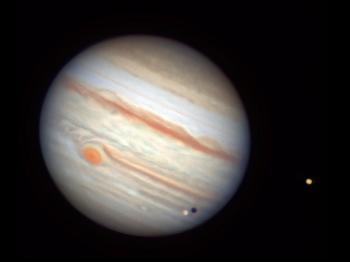 Figure 10: Jupiter, Io (right) and Europa (with shadow) as imaged on 24 September 2022 around 22:32UTC. All recordings are videos of 60 seconds per filter at 4ms (L) and 10ms (RGB). In total, about 90Gb of data was collected. Processing was done with AutoStakkert!3 where, depending on the quality, between 10% and 30% of the data was stacked. Then de-rotation was applied in WinJupos and noise-reduction, 20% saturation and 17% vibrancy in PSP. Then created the animation using seven of the recordings using EzGif.com. One recording stood out on the 24th. Around 22:32UTC seeing was at its best, allowing to further scale up this frame of the animation by 200% with only noise reduction applied in Topaz. Click here for the full image. 2 September 2022Finally after several years of being very low in the sky, the major planets now raise to decent altitudes. Last week Saturn gave a reasonable result, so this week I decided to give Jupiter it's first try. Recording made with Celestron C11 XLT EdgeHD @ f/20, ZWO LRGB filters and ZWO ASI174MM @ gain 300. Exposure times were 5ms for L and 10ms for RGB. Focusing was done on Ganymedes using a Bahtinov mask. Four movies of 90 seconds were recorded with FireCapture, stacked with AutoStakkert3, derotated and combined using WinJupos. The image is then scaled 200% in PSP using bicubic resize, after which noise reduction was done in Topaz and the image was given a bit extra saturation in PSP again. Click here for the full image. 27 September 2021On 27 September 2021 I was doing a several tests with the back-focus distance of the Celestron C11 XLT EdgeHD. Seeing was poor, but transparency good, so I decided to do some recordings in LRGB using the ZWO ASI174MM, ZWO ADC, and TeleVue 2x PowerMate. The image shows Jupiter with (from left to right) Io, Ganymede and Europe. Recording done in FireCapture, processing done in AutoStakkert!3 and PSP. Despite its low altitude of 22°22' the image came out quite reasonable. Click here for the full image. 20 December 2020If I checked out well in Stellarium, Saturn and Jupiter can be captured on one plate for three days this year (20, 21, and 22 December 2020) with the combination of C11 with ZWO ASI174MM (the image was captured without Barlow, but with ADC). Tonight (20 December) was the first chance, the two others opportunities will follow for the next two days. The circumstances were far from ideal: a lot of clouds, but fortunately also a few holes, and the planets at low altitude. Saturn was at an altitude of 11° 13′, Jupiter at 11° 04′. Their separation was roughly 9.5'. Instead of using my usual 4 x 120s script, I set FireCapture up to make 30 second SER movies on demand. Then in between clouds (between 4:05 PM to 4:15 PM UTC) various recordings were made in LRGB, constantly manually adjusting the exposure to adjust for the thin cloud cover. In this way, several videos were recorded per filter, the majority of which had to be stopped well before the 30-seconds limit. The remaining movies, usually with no more than a few thousand frames, were subsequently stacked and the best chosen for further processing. In the end the RGB stacks were combined into a colour plate and the L-stack used as luminance. Finally in PSP the colours were corrected and the brightness increased. The whole image was constantly processed as a whole to maintain the difference in brightness between Saturn and Jupiter. Jupiter also shows the moons Ganymede (left) and Europe. Io was in front of Jupiter at the time of the image, its shadow is just visible. Click here for the full image. 29 June 2019On 29 June 2019 I imaged Jupiter again. This evening Io and Ganymedes were close to the planet and could be captured in the same frame. Io is the moon at the top, Ganymedes at the bottom. The time-lapse consists of 5 frames spanning 36 minutes and 12 seconds. A total of 65Gb of data was collected with the C11 EdgeHD, 2x PowerMate, ZWO ASI290MC and ZWO ADC. 25 June 2019On 25 June 2019 seeing finally became quite good. A total of 108Gb of data was collected during twelve recordings over a period of 1 hour, 3 minutes and 57 seconds using the C11 EdgeHD, ZWO ASI290MC, ZWO ADC, and Televue 2x PowerMate. Capturing was done using FireCapture, while processing was done in AutoStakkert and PaintShop pro. The twelve recordings were processed to become 12 jpeg files, which were then combined using an online gif-animation maker. 24 June 2019After the previous Jupiter image I decided to install a 2x PowerMate. Sadly enough the cloud cover increased, consuming most of the light (although visual still attractive through the SkyWatcher Esprit. This image was made using only 550 frames, so still need to increase the camera output. Image taken with C11 EdgeHD, 2x PowerMate, ZWO ASI290MC. Video of 5500 frames, 550 stacked. 24 June 2019Still learning a lot about planetary imaging, and a long way to go. On 22 July 2019 I imaged Jupiter, but again with poor seeing. Reason was that I had just swapped my C11 XLT for a C11 EdgeHD and had acquired a ZWO ASI290MC with a ZWO ADC (Atmospheric Dispersion Corrector). Wanting to test this trio made me decide to image Jupiter despite the conditions. In the meanwhile I had learned that exposure time should be kept as short as possible (10ms in this case), while the stack length should be as large as possible. On 24 July seeing was reasonable, but sadly enough it came with a thin cloud cover. As I wanted to experiment with various settings in recording and processing, I took images of Jupiter despite the conditions. Image taken with C11 EdgeHD, no PowerMate, ZWO ASI290MC. Video of 11000 frames of which 1100 were stacked. First attempt on 23 July 20158Adjacent image was taken on 23 July 2018 on a warm summer night and at an altitude of only 11 degrees, causing it to be slightly blurred. If you have any questions and/or remarks please let me know. |
InFINNity Deck... Astrophotography... Astro-Software... Astro Reach-out... Equipment... White papers...
Deep Sky... Solar system (Main)... Solar System (Asteroids)... Solar System (Meteors)... Solar System (Comets)... Man-made objects...
Sun Mercury Venus Moon Mars Jupiter Saturn Uranus




